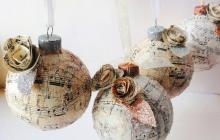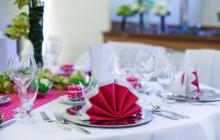Size: 16 cm.
You will need:
skein of Spud & Chloe Sweater (55% wool, 45% cotton), 100 g/146 m, green (7502), leftover black yarn, set of 4 stocking needles 5 mm.Body:
1st row: persons. P.
Row 2: (k1, yarn over, knit 1, yarn over, knit 1), repeat to end, get 15 sts.
3rd row: persons. P.
4th row: (k1, yarn over, knit stitch to last stitch on needle: yarn over, knit 1), repeat to end of row
5th row: persons. P.
Repeat rows 4-5 until there are 15 sts on each needle - we get 45 sts in total.
Next row (a row of decreases): (3 persons., 2 persons together.), repeat to the end of the series - we get 36 p.
Next row (reduction row): (2 persons, 2 persons together), repeat to the end of the series - we get 27 p.
Knit 2 rows of faces. P.
Track. row (row of decreases): (1 person., 2 persons together.), repeat to the end of the series - we get 18 p.
Track. row: faces. P.
Track. row (reduction row): (2 persons together.), repeat to the end of the row - we get 9 p., Cut the thread, stretch it through 9 p., fasten the thread.
Paws (4 parts):
Cast on 3 sts on stocking needles (place 1 st on each needle).To knit circular rows(without turning) faces. loops - 7.5 cm.
Track. row: knit each p. 2 times: behind the back and behind the front walls - we get 6 p.
Track. row: faces. P.
Track. row: knit each p. 2 times: behind the back and behind the front walls - we get 12 p.
Knit 4 rows of faces. P.
Fill with filler
Place 12 sts on 2 knitting needles (6 sts on each knitting needle), close the loops with the 3rd knitting needle, while sewing the foot
Fingers (12 children):
Pick up 1 st.1st row: knit a loop 3 times: behind the front, behind the back and again behind the front wall - we get 3 p.
2nd row: persons. P.
3rd row: out. P.
4th row: knit without turning, remove the st., knit 2 persons together., throw the removed one on the knitted one - we get 1 st.
Sew on 3 fingers to each foot (see fig.)
Head:
Cast on 9 sts on stocking needles (place 3 sts on each needle). Knit in circular rows (without turning)1st row: persons. P.
2nd row: (knit a loop 2 times: behind the front and behind the back walls), repeat to the end, we get 18 p.
3rd row: persons. P.
4th row: (knit a loop 2 times: behind the front and behind the back walls), repeat until the end of the row, we get 36 p.
Put a label. Knit exactly faces. n. 4 cm long from the mark.
Next row (reduction row): (4 persons, 2 persons together), repeat to the end of the series - we get 30 p.
Next row (reduction row): (3 persons, 2 persons together), repeat to the end of the series - we get 24 p.
Fill the body with filler, knitting the following rows, add filler
Place 12 sts on the thread, knit on the remaining 12 sts.
Eyes
place 4 sts on each needle:Connect 12 sts in a circular row, knit in circular rows without turning
Knit 4 rows of faces. P.
Next row (reduction row): (2 persons, 2 persons together), repeat to the end of the series - we get 9 p.
Cut yarn, pull through 9 sts, fasten off yarn.
Run the second eye in the same way.
Face:
using a needle and black thread, sew a smile, eyebrows and eyes on the frogSew the legs to the body. Sew the head to the body.
WORK DESCRIPTION:
Recruiting for knitting needles 28 loops and distribute on 4 knitting needles as follows: 1st spoke- 8 loops - this is the back, (and only one half of these 8 loops is indicated on the diagram).
2nd spoke- 7 loops - this is the side, the 3rd knitting needle - 6 loops - this is the abdomen, and the 4th knitting needle - 7 loops - this is the second side.
Connecting knitting needles in a ring and knit 2 circles.
Next, we start making additions. The diagram shows: V - untie 1 persons. crossed from a broach. And I did it differently: untying from one person. two loops, first behind the far wall of the loop, and then, without removing this loop from the left knitting needles, once again knitted it with the front for the near (front) wall of the loop. You do what is more convenient for you.

In the 3rd circle, we make increases as follows: 1st spoke(back) from the 2nd loop we untie two loops and from the penultimate (seventh) too we untie 2 p.; 2nd spoke(barrel) we make 1 increase in the center, that is, we knit two loops from the 7th central loop; 3rd spoke(belly) - we untie from one loop, two on either side of the central loops of this spokes, that is, we make an increase in the 3rd and in the 4th loop; 4th spoke(2nd side) we make an increase in the same way as on the 2nd spoke, that is we untie two loops from the central (7th) loop on this spoke.
Next 3 laps we knit directly, without any additions.
In the 7th round, we make increases in the same way as in the 3rd round, but DO NOT add loops on the abdomen - this is our 3rd knitting needle, increases on it are made every other time.

So we continue to knit, making increases on three spokes first, second and fourth every three laps, and on the third spoke we add loops only after 6 circles (symmetrically from 2 sides from the central loop of the back).
In this rhythm, you need to increase 7 times on the 1st, 2nd and 4th knitting needles and 4 times on the 3rd spoke. As a result, after all the increases you have on the first spoke there should be 22 loops, on the second, third and fourth spoke- 14 loops each, and the total number is 64 loops.
For 4 spokes you now have such a pyramid without a top (or a truncated cone) about 10 cm high.
1st spoke(back): remove the 1st loop as a facial one, the 2nd knit front and stretch through it the removed loop. Knit 2 loops together in the center knitting needles and in the end.
2nd spoke(side) make one decrease ( we knit 2 loops together) at the end knitting needles, at the belly.
3rd spoke(abdomen) in the center knitting needles we knit 2 loops together.
4th spoke(2nd side) the same as on the 2nd spoke.
Repeat these reductions 3 more times every 4 rounds. After that for all spokes 10 loops should remain.
One row we knit smooth.
Next we have to untie head. Therefore, the next 8 circles of increase will be done only on the 1st spoke(former back, now head). We add loops from the 2nd and 4th loops, from the central loop of the head and from the last 2 loops of the 1st knitting needles. And so 3 times. After that 5 rows we knit smooth. Then we will decrease again.
On the 1st spoke 2 times 2 loops together at the beginning of the knitting needle, 1 decrease in the center knitting needles and in the end knitting needles again 2 times 2 last knitting needles together.
2nd spoke– Knit the last 2 stitches together.
3rd spoke decrease in the center of the abdomen.
4th spoke- 2 first loops we knit together. And so 3 times.
I didn't make any more cuts. Knitted straight 8 rows. Then close all loops. Leave the thread longer, so that later you can thread it around the circumference and pull the hole. The body is ready to be filled.

I also knitted the hind legs in my own way, or rather one according to the description, and made the other whole.
To do this, start it vice versa from the top and having done everything according to the description, she did not only sew open loops, but continued to knit as described below. Thus, the back foot turned out without a seam on the fold and I liked it more.
Also, I didn't want to untie belly according to the description and then sew it on the torso. I just embroidered my chest a little frogs. I won’t say that this made my frog more beautiful, but I’m telling you, just as an option. And it's up to you to decide how your frog, knitted, decorate.
But, I want to note that contrary to my fears, my knitted frog our baby fell in love and is not at all afraid, despite the fact that my knitted frog turned out ugly. After all, love is not only for beauty.
If something else remains incomprehensible, please contact me, write to me, I will try to help, add more explanations and photos, if necessary.
This wonderful toy is crocheted in stockinette stitch from the remnants of yellow and green yarn on knitting needles No. 4.
Toy size: 30 x 15 cm.
interesting selection on the site 37 children's models onlyToy knitting technique: hosiery knitting (persons. R. and out. R. - persons. P.).
Description of the work of the toy - frog
Back (knit 1 piece): With green yarn, cast on 5 sts.
1st row: knit faces. P.
2nd and all even rows on the 20th row: knit persons. p., adding 1 p. on both sides. On the needle = 25 p.
21st-48th p.: Knit persons. P.
49th-52nd: cast off at the beginning of the row 4 sts each. On the needle = 4 sts.
Row 53: Cast off all stitches in one row.
Abdomen (knit 1 piece): With a yellow thread, dial 5 sts on the knitting needles. Then continue the work according to the description of the back.
Side: With a green thread, dial 4 loops on the knitting needles.
1st p.: persons. P.
2nd and all even rows on the 18th row: knit persons. p., adding 1 p. on both sides. On the needle = 12 p.
19th-118th p.: persons. P.
In the 119th, 124th, 129th and 134th p. decrease on both sides by 1 p. On the needle = 4 p.
120th-123rd, 125th-128th, 130th-133rd, 135th-136th r.: persons. P.
137th row: close all loops in one row.
front paw (knit 2 parts):
With yellow yarn, cast on 10 sts on the needles.
1st-5th p.: persons. P.
6th row: cast off 5 sts and knit faces. n. to the end of the row. On needle = 5 sts.
7th-13th p.: persons. P.
Row 14: Cast off all stitches in one row.
Thus, tie 4 children.
hind leg (knit 2 parts):
With a green (yellow) thread, dial 20 sts on the knitting needles.
1st-6th p.: persons. P.
7th row: Cast off 10 sts and knit to end of row. p. On the needle = 10 p.
8th-18th p.: persons. P.
19th, 21st and 23rd p.: Decrease 1 p. at the beginning of the row. On needle = 7 sts.
20th, 22nd, 24th p.: persons. P.
25th row: close the loops in one row.
membranes (knit 4 parts):
With yellow yarn, cast on 7 sts.
1st p.: persons. P.
2nd row: cast off 3 sts and knit faces. n. to the end of the row. On needle = 4 sts.
3rd p.: 4 persons. p., dial new 3 p. On the needle = 7 p.
8th and 9th p.: persons. P.
10th row: close the loops in one row.
Eyes (knit 2 parts):
with green thread, dial 7 sts on the knitting needles.
1st row: facial loops.
2nd row: add 1 st on both sides. On the needle = 9 sts.
3rd-7th p.: facial loops.
8th row: decrease on both sides by 1 p. On the needle = 7 p.
9th row: facial loops.
Row 10: Cast off all stitches in one row.
Pass the thread along the edge of the resulting circle and pull it off. Fill with syntepon.
Assembling the toy
Fold the parts of the front paw with the right side inward and sew. Sew on the webbing. fill with sintepon. Do the hind legs in the same way.
Sew the details of the back, belly and sides, leaving 3 cm open. Fill with padding polyester and sew up the hole. Sew paws, eyes according to the photo.
Soft toys are the most favorite for every kid, and if they are also made by the hands of a mother, sister or grandmother, then such a toy will be the most valuable in the collection of a young connoisseur. Knitted toys with knitting needles are becoming more and more popular every year. Modern lovers of needlework are increasingly paying attention to them. Such toys will be unique, unique gifts. In addition, they are absolutely safe, which is very important for the health of young children.
How to tie a butterfly
Knitting toys for beginner needlewomen should be carried out with simpler products. It is best at this stage of learning to try to portray a beautiful butterfly. To do this, you need to take 100% acrylic yarn. Yellow and green go well together. So you need to take some cotton-type yarn. For example, black, red and orange threads are suitable. For stuffing it is better to take a synthetic winterizer. Eyes can be purchased ready-made at any clothing store. From the knitting needles you will need a pair with sizes No. 3. Additionally, you will need a hook with size No. 3.5.
 To knit a butterfly, you will need to take 100% acrylic yarn.
To knit a butterfly, you will need to take 100% acrylic yarn. How to tie a butterfly toy? Start work with the body. It is necessary to dial 25 loops on the knitting needle with yellow yarn. It is required to make 14 straight rows with a satin stitch. After that, from all sides when knitting, you need to start reducing the number of loops. For example, on every sixth row, you need to reduce 1 loop. This should be done until only 7 loops remain, which must be fixed and covered. At the end, you should make a connecting seam in parallel and fill this part with synthetic winterizer. You can thread the detail in three places to show the head and torso of the butterfly.
Next, you can proceed to the wings of the insect. They can be made with green yarn. First you need to make 30 loops. With the facial method, you need to make 100 lines. Then the whole part must be bent and sewn with a seam from the inside out. You can make the corners of the part more round for beauty. Then, too, you need to fill everything with filler. Next, the part should be pulled together with threads in the central part. Now her wings are ready and they can be sewn to the body from the back.
A beautiful butterfly must also have hair. For this, you will need orange threads. You just need to make air-type loops with a hook. Each thread should be fixed near the head. Paws for an insect are also needed. They can be made from black or brown threads. You will also need to crochet stripes. Their length is no more than 10 loops. Then all the details are combined, then you need to glue the eyes. Additionally, you can embroider a mouth - and a beautiful toy in the form of a butterfly is ready. Knitting patterns for toys of this simple type are not even needed.

Amigurumi are small knitted toys. Try to create an amigurumi frog with your own hands. They are very cute.
You can tie such a friend to your or any other child as a gift. Children love small toys that fit in their pockets: they carry them everywhere with them, get together and organize impromptu puppet shows.
Decorate clothes, bags, children's backpacks and shoes. The little man will like the frog if you attach it to his phone or use it as a keychain.











For an acquaintance or friend who collects funny freshwater animals, amigurumi will be a wonderful piece for the collection.
A knitted frog can be a wonderful piece of furniture. They are placed on house plants, in flower pots, fasten to furniture or curtains.
Crochet patterns for a frog in the style of amiugurumi
To work with a hook, you need to pick it up so that it is thinner than the yarn from which the amigurumi will be knitted. This will help make the knit tight, without holes through which the filler can peek out from the inside.
It is better to take the yarn that does not fluff: freshwater has a smooth skin. For the frog - Green colour different shades. If the toy is in clothes, then you need to pick up threads of the same density.


As a filler, you can take holofiber, synthetic winterizer, granulate balls. To a small child well suited cereals, seeds, coarse sand. This will help the development fine motor skills when feeling. The disadvantage of such toys will be that they cannot be washed.
Photo master class on knitting an amigurumi frog
In amigurumi, the main part is the head. Frogs are usually depicted with large expressive eyes. Therefore, it is worth buying plastic eyes for toys in needlework stores.






